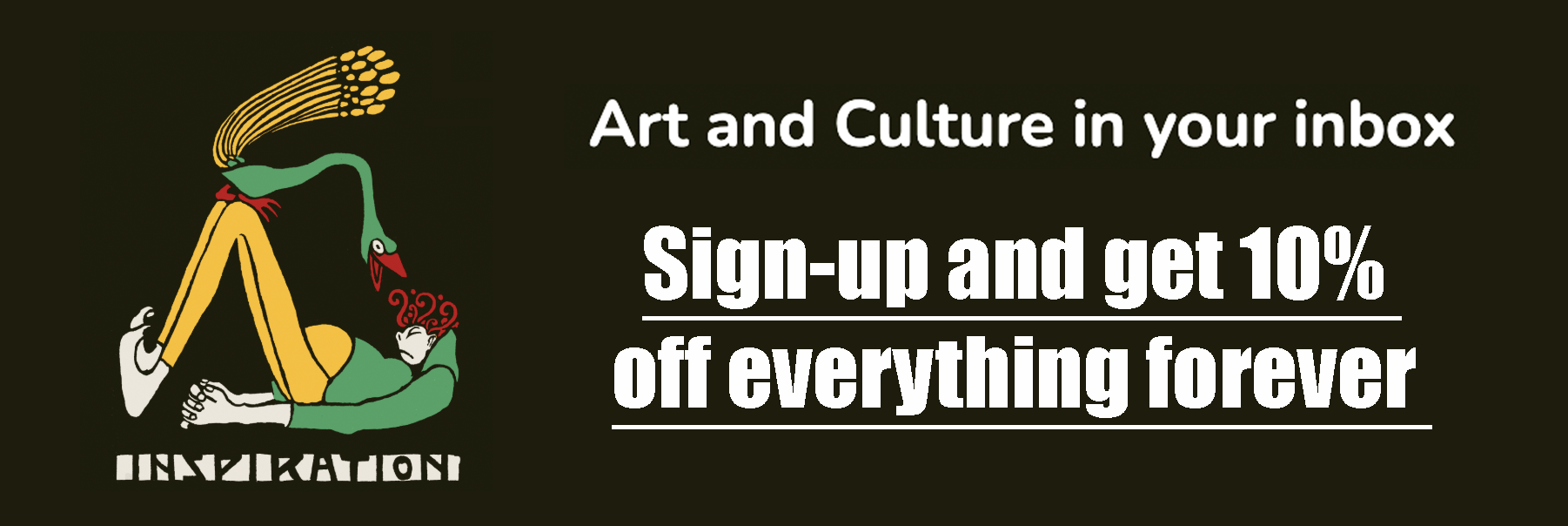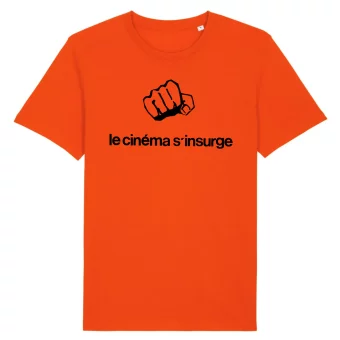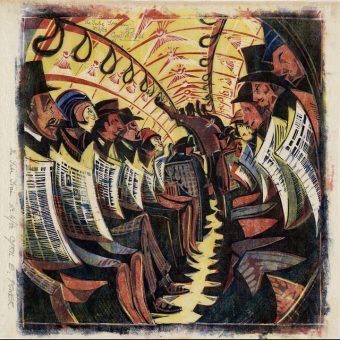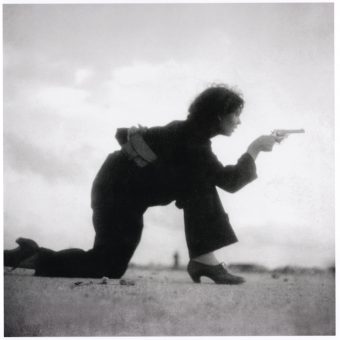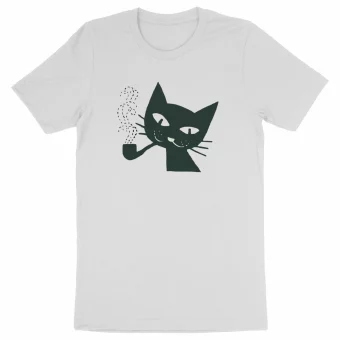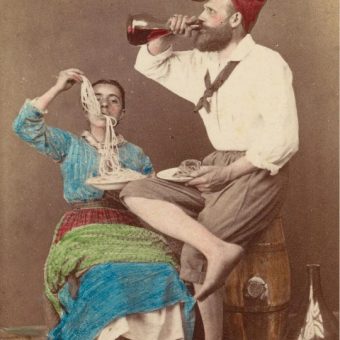“Disobedience is the true foundation of liberty. The obedient must be slaves.”
― Henry David Thoreau,
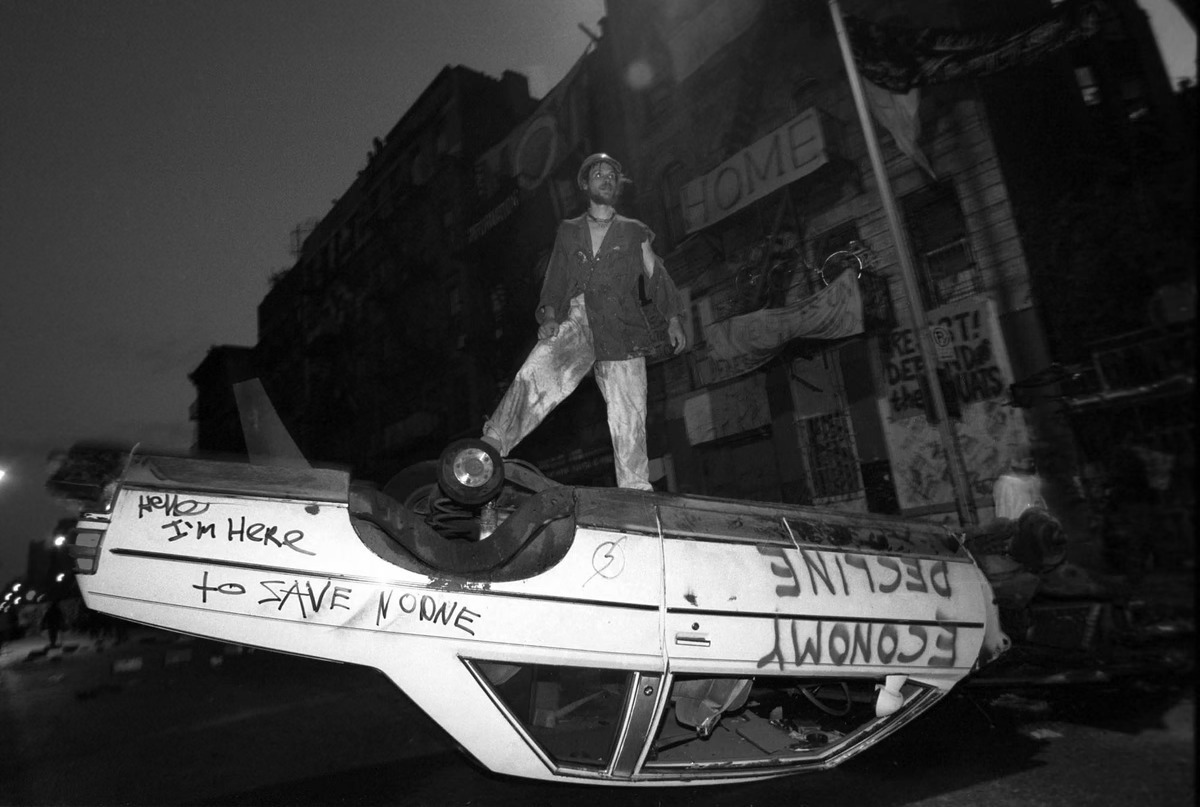
Squatters attempt to defend their building by blocking the street with overturned cars and trash before an expected attack by the police on East 13th Street. © Andrew Lichtenstein
Photographs of demonstrations in New York City between 1980 and 2000 are at the Whose Streets? Our Streets! exhibition at the Bronx Documentary Center. The show explores New York protest and the locals’ reactions to police brutality, gentrification, racism, AIDS, gay and lesbian rights, abortion, U.S. foreign policy and military actions, education and labor relations.
“While this cohort of photographers had made very powerful photographs of protests in New York City during these tumultuous decades, because they were working independently and before the advent of the internet and social media, much of their work had never been seen,” says Tamar Carroll, the show’s co-curator.
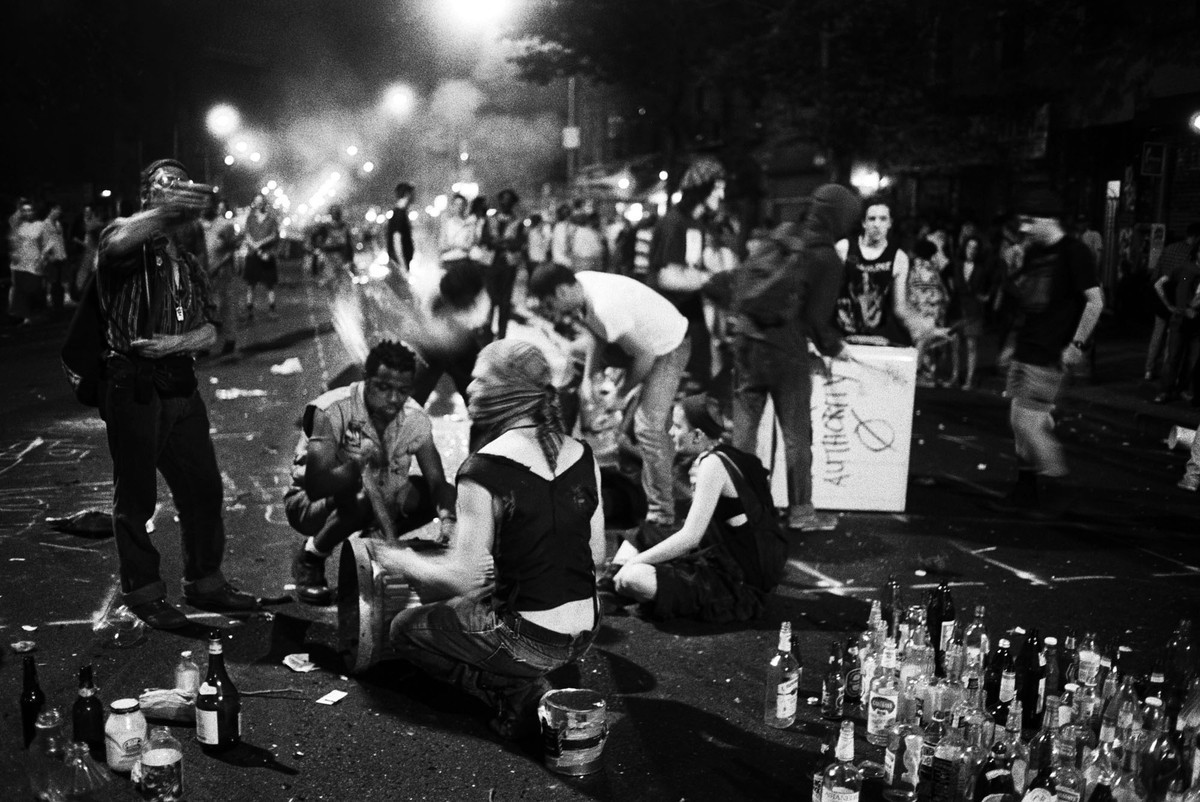
Manhattan, May 27 1991, On Memorial Day, protesters of Tompkins Square Park movement prepare to confront police on Avenue A.
Housing
The Lower East Side was a flashpoint in conflicts over housing and homelessness in the 1980s and 1990s. The gentrification of buildings like the Christodora drew professionals and even celebrities to the neighborhood, historically home to waves of poor immigrants, including Jews, Puerto Ricans and African Americans, who moved there in the 1950s and 1960s. Artists and housing activists had established squats in vacant buildings, restoring the buildings and claiming ownership through sweat-equity and landlords’ failure to pay city taxes for more than 10 years. A large homeless tent encampment and an open-air drug market occupied much of Tompkins Square Park, to the consternation of City officials and some neighborhood residents.
In August 1988, the police attempted to impose a 1 am curfew on the park and to clear it of homeless people; officers incited a riot by surrounding the park and violently charging the crowd, which included bystanders, neighborhood residents, homeless people, journalists, and housing activists. Over the objection of housing activists, the City closed Tompkins Square Park from June 1991-July 1992, officially for restoration but also to prevent homeless people from taking up residence in the park. In May 1995, tensions flared again as police wearing riot gear and using an armored vehicle evicted squatters from two tenements on East. 13th Street.

Manhattan, January 23, 1991. ACT UP “Day of Desperation” protest at Grand Central Station. The protest was staged in response to President George H. W. Bush spending billions of dollars on the Gulf War while claiming there was no money for much-needed increases in AIDS programs. On January 23rd ACT UP staged actions throughout the five boroughs, culminating in a large action at Grand Central.

Bensonhurst residents hold up watermelons to mock African American protestors who took to the streets of the largely Italian neighborhood in Brooklyn following the acquittal of Bensonhurst resident Keith Mondello in the shooting death of 16-year-old African American Yusef Hawkins on May 19, 1990. Hawkins, who had gone to the neighborhood to look at a used car, was met by a white mob and shot to death. © Ricky Flores
Race
In working-class white ethnic enclaves, some residents used violence to preserve racial segregation. Three black men – Willie Turks, Michael Griffith, and Yusuf Hawkins – died at the hands of white mobs in the 1980s. In 1989 and 1990, civil rights leader Rev. Al Sharpton staged protest marches through the largely Italian-American neighborhood of Bensonhurst to protest both Hawkins’ killing and the acquittal of his accused assailant. White counter-demonstrators chanted racist slurs and held watermelons, a symbol of racist iconography dating back to the 19th century.
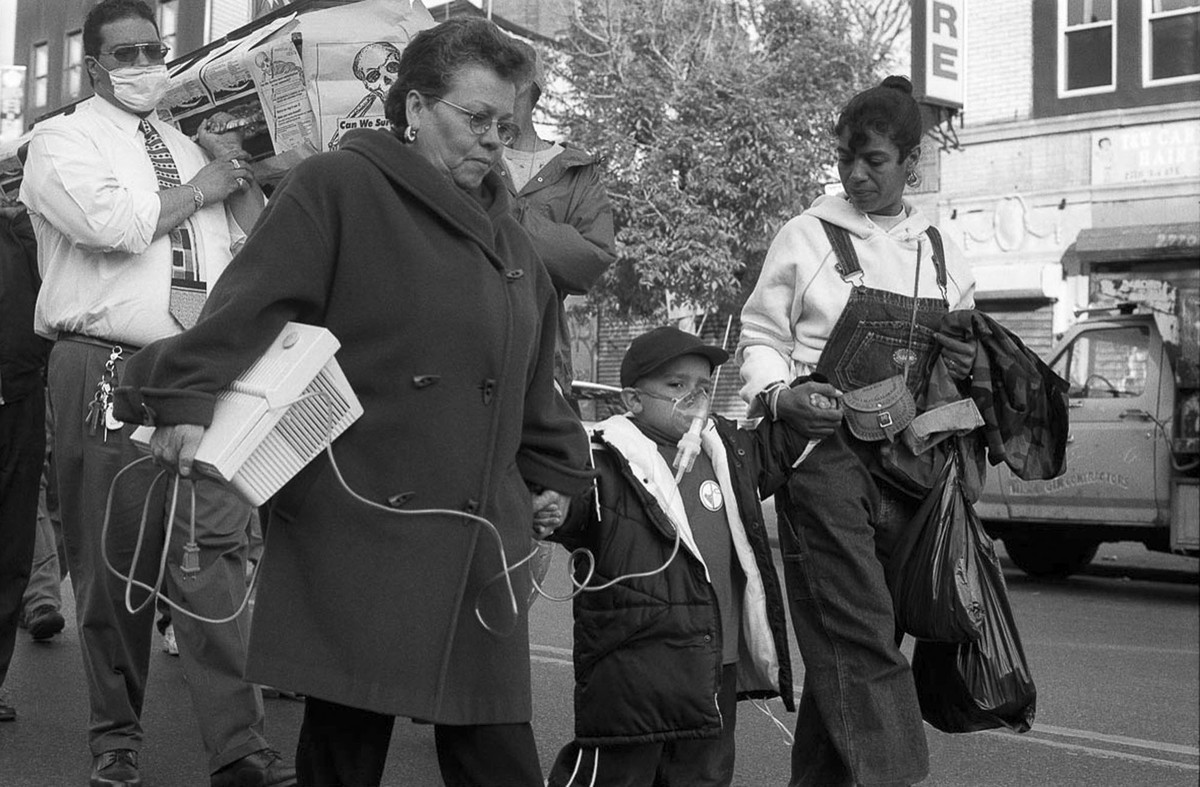
Bronx, 1990, A March and rally protesting the Bronx Lebanon Hospital medical-waste incinerator in the South Bronx. It closed in 1991. The grandmother carried an asthma ventilator as a symbol of the issue.

Manhattan, April 9, 1991. Students sit on a parked car outside an occupied building on the City College campus during the CUNY student strike against proposed tuition hikes and budget cuts.
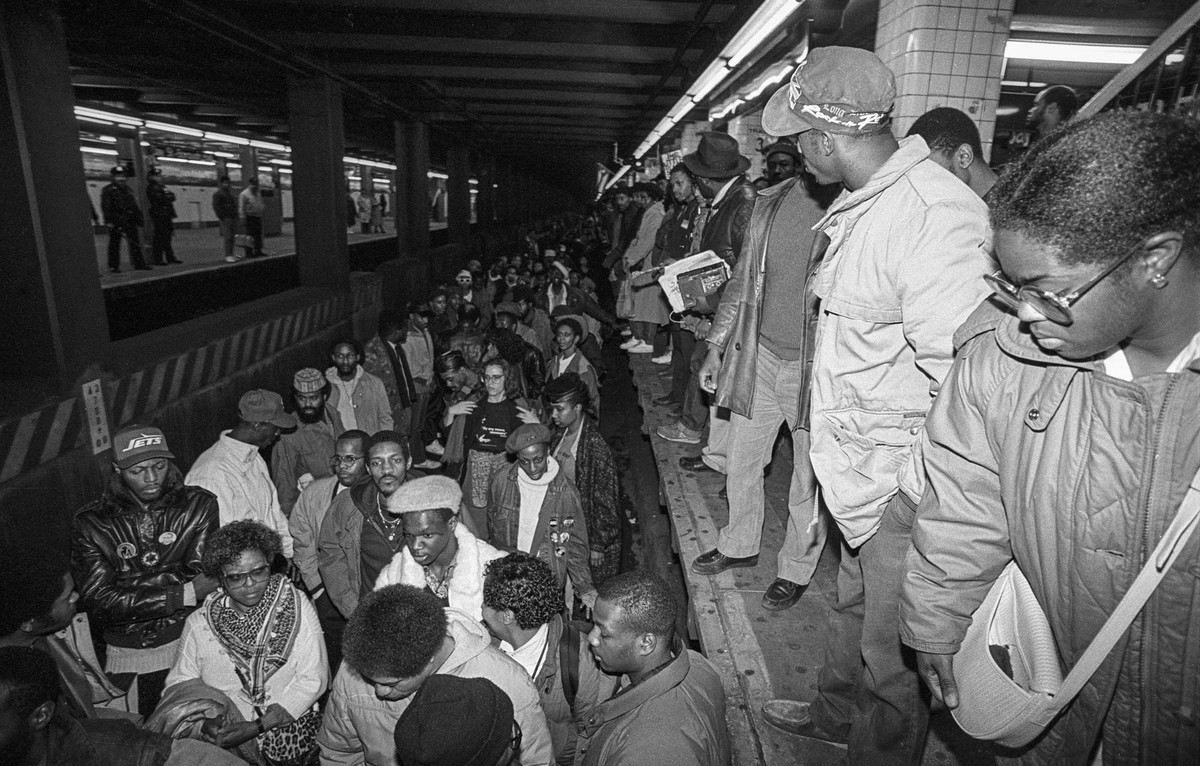
Brooklyn, Jay Street and Boro Hall Station, Day of Outrage demonstration after the Howard Beach verdict on December 21, 1987. Day of Outrage demonstration at the Jay Street-Borough Hall subway station following the Howard Beach verdict on December 21, 1987 in which three defendants were found guilty of manslaughter in the death of Michael Griffith who was beaten and chased by a white mob onto a highway where he was struck by a car. © Ricky Flores
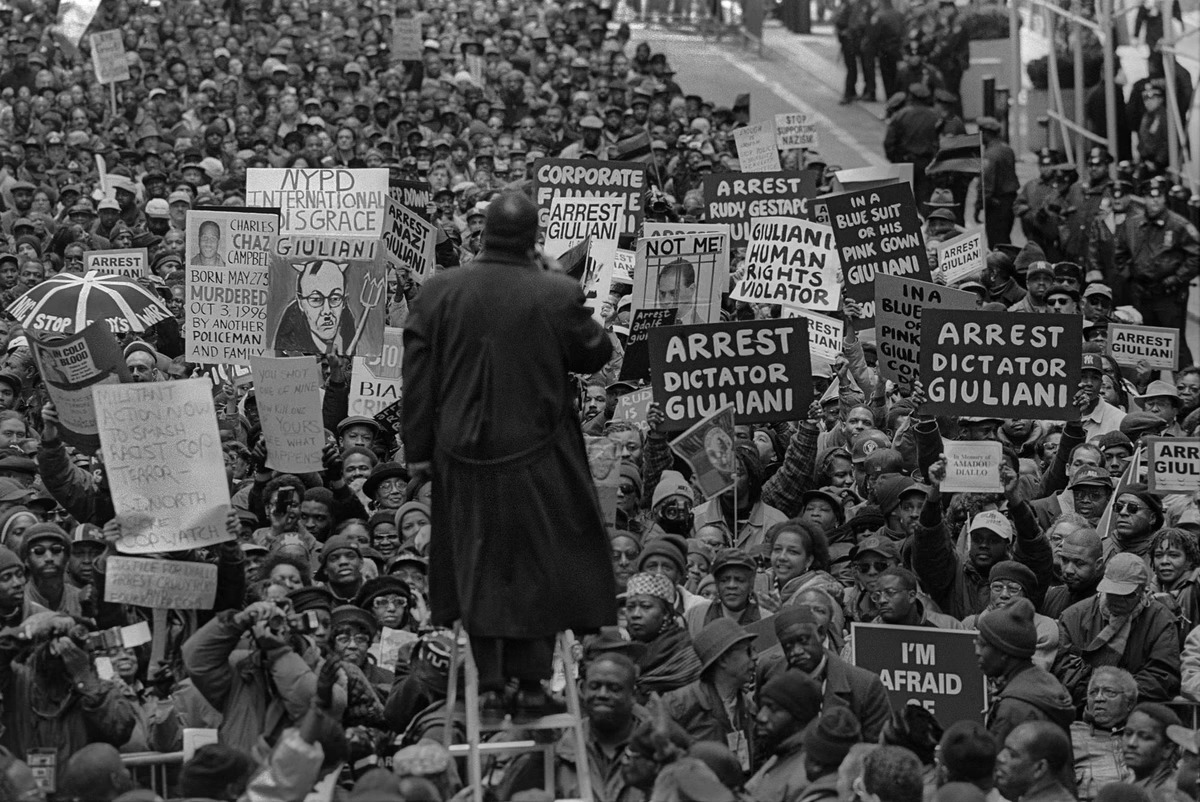
Manhttan, 1999: Demonstrators gather in front of the New York Stock Exchange to demand the indictment of the four policemen who killed Amadou Diallo, a 23-year-old unarmed immigrant from Guinea.
© Frank Fournier / Contact Press Images
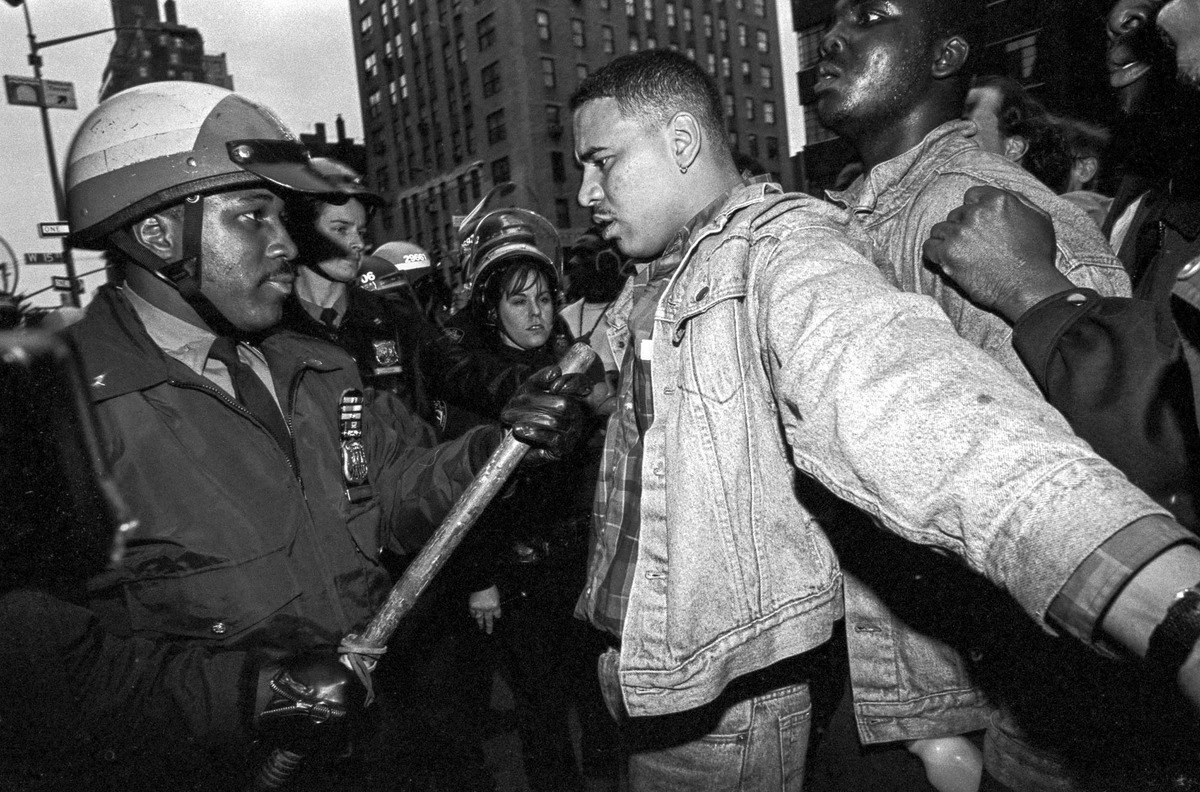
Manhattan, 1992: A policeman confronts a protester during a demonstration in response to the acquittal of the officers involved in the beating of Rodney King. © Linda Rosier
New York Protests Police Brutality
Among the most notorious cases were Michael Stewart, a 25-year-old African American student who died in 1983 following a severe beating by Transit Police arresting him for spray-painting graffiti in the subway; Eleanor Bumpurs, a 66-year-old mentally ill African American woman killed in 1984 by police who came to evict her from her Bronx apartment; Jose (Kiko) Garcia, a 23-year-old Dominican immigrant killed in 1992 by police during a drug sweep whose death touched off rioting in Washington Heights; Anthony Baez, a 29-year-old Latino who died in the Bronx in 1994 after being choked during arrest (he had hit a police car with a football while playing catch with his brother); Abner Louima, a 30-year-old Haitian immigrant who was arrested and sodomized with a broomstick in a Brooklyn police station in 1997; Amadou Diallo, a 22-year old Guinean immigrant who was fatally shot by police in the doorway of his Bronx apartment in 1999; and Patrick Dorismond, a 26-year-old African American security guard killed in 2000 by undercover NYPD agents after they approached him to ask where they could purchase marijuana.
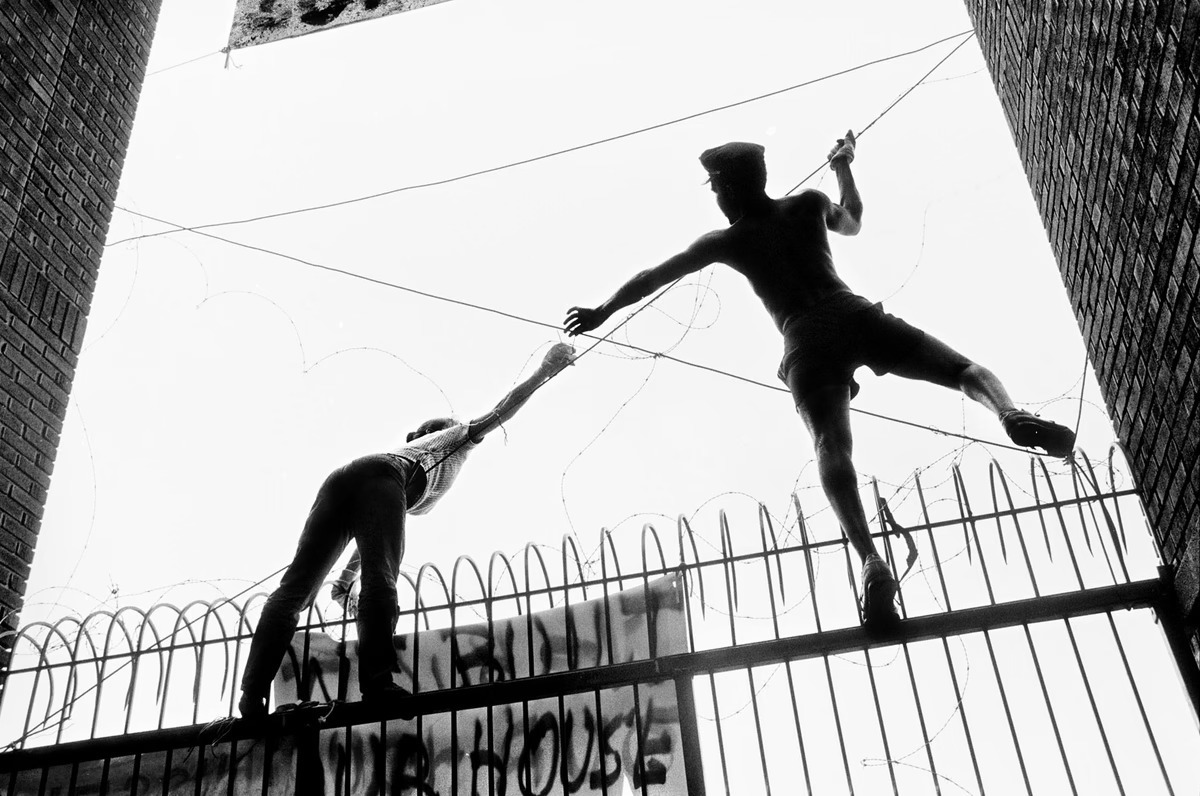
Bronx, 1988: Tenants and supporters barricade themselves against eviction by New York City marshals on Cypress Avenue in the South Bronx. The tenants, mostly low-income New Yorkers and artists, took over an abandoned building, invested tens of thousands of dollars and several years of their labor, replacing the roof, boiler, and other building infrastructure. Despite this, the city sold the building to a developer who eventually evicted the families. © Michael Kamber
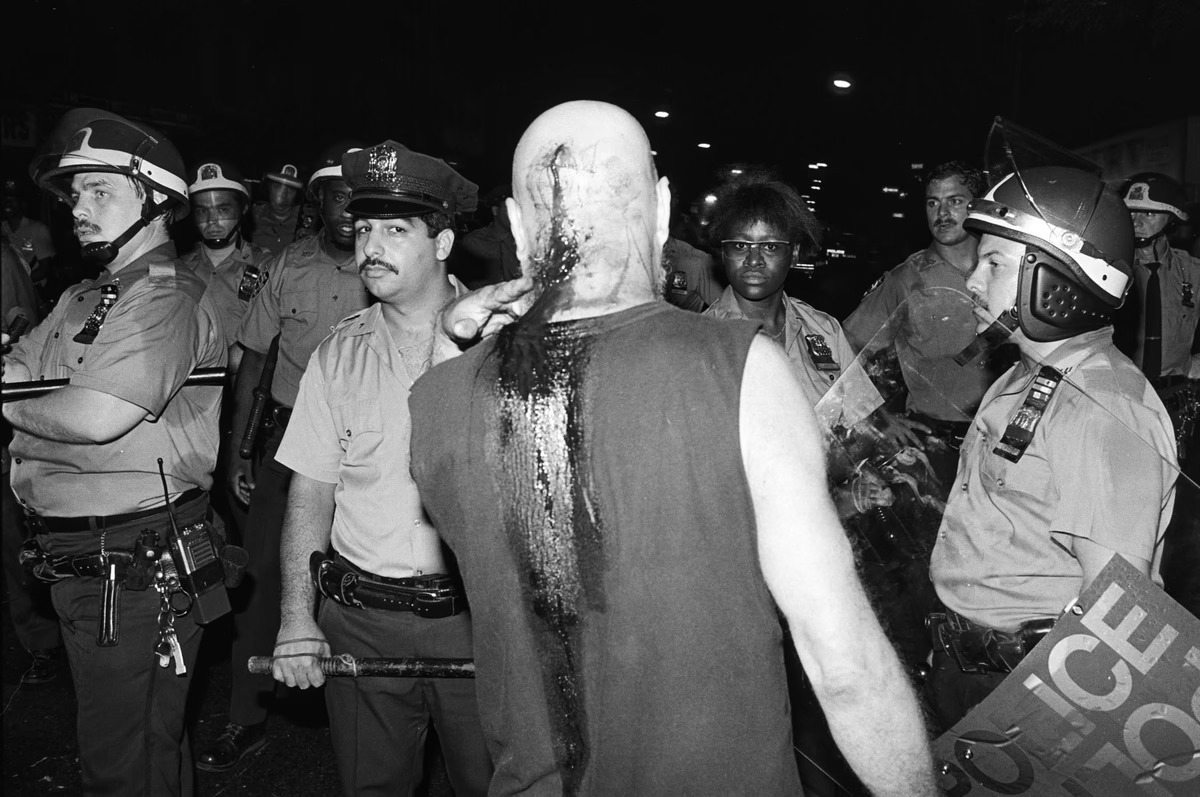
Manhattan, 1988: A protestor with a bloodied head walks toward police officers during a riot in Tompkins Square Park. © James Hamilton
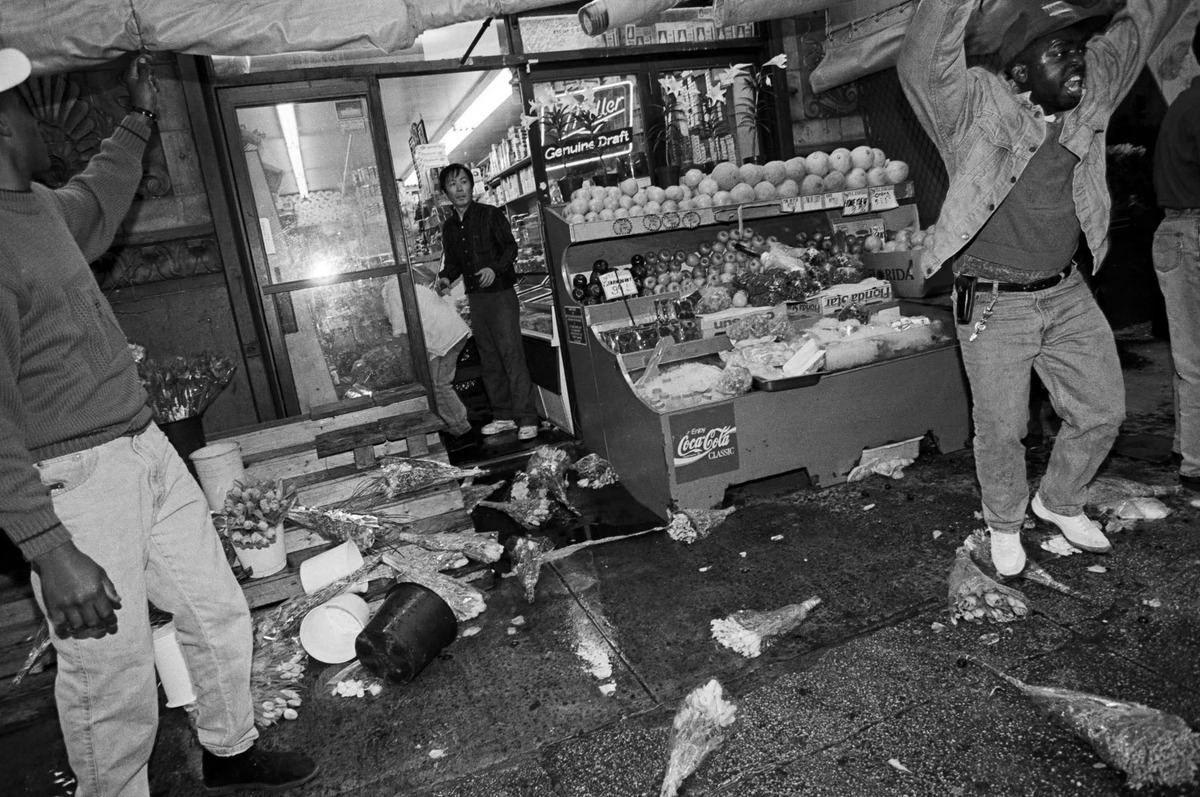
Manhattan, 1992: Protesters take to the streets in response to the acquittal of the officers involved in the beating of Rodney King. Some Asian-owned groceries such as this one were vandalized. © Linda Rosier
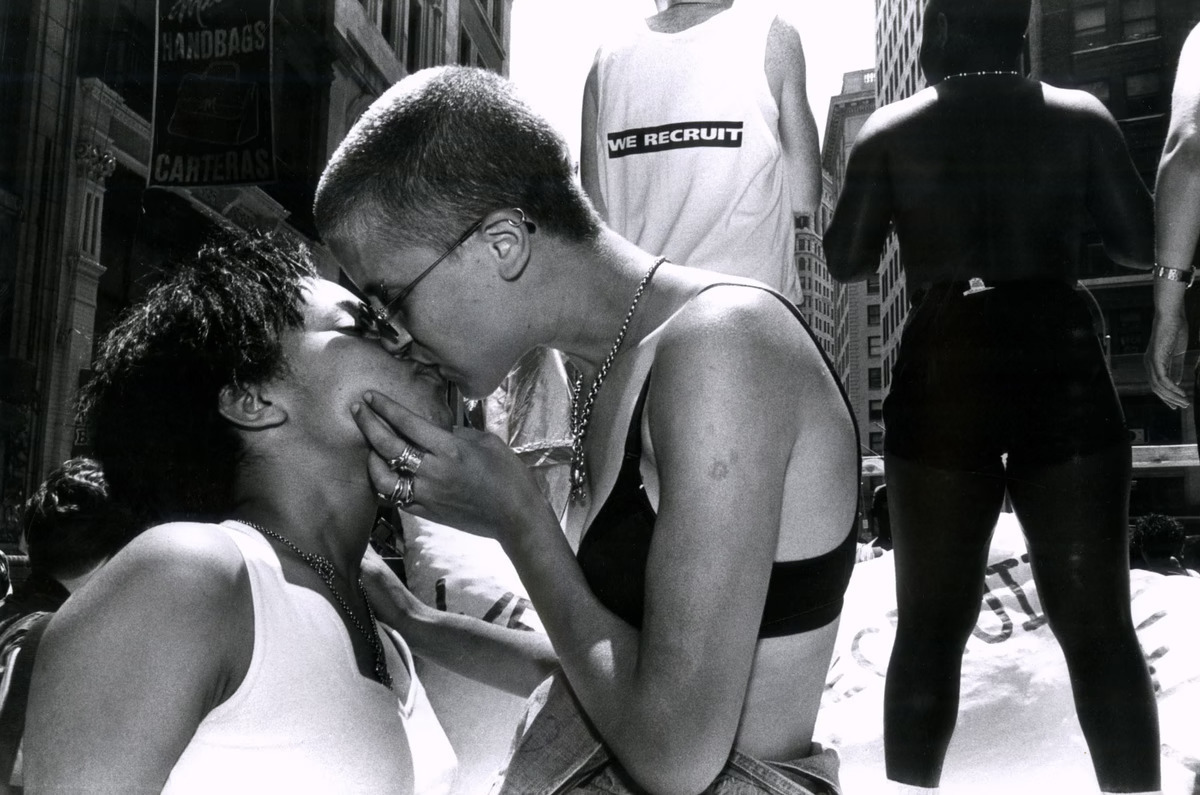
Manhattan, 1993: Two women kiss during the first Dyke March. The Lesbian Avengers began the annual tradition of marching down 5th Avenue from Bryant Park to Washington Square Park. © Carolina Kroon
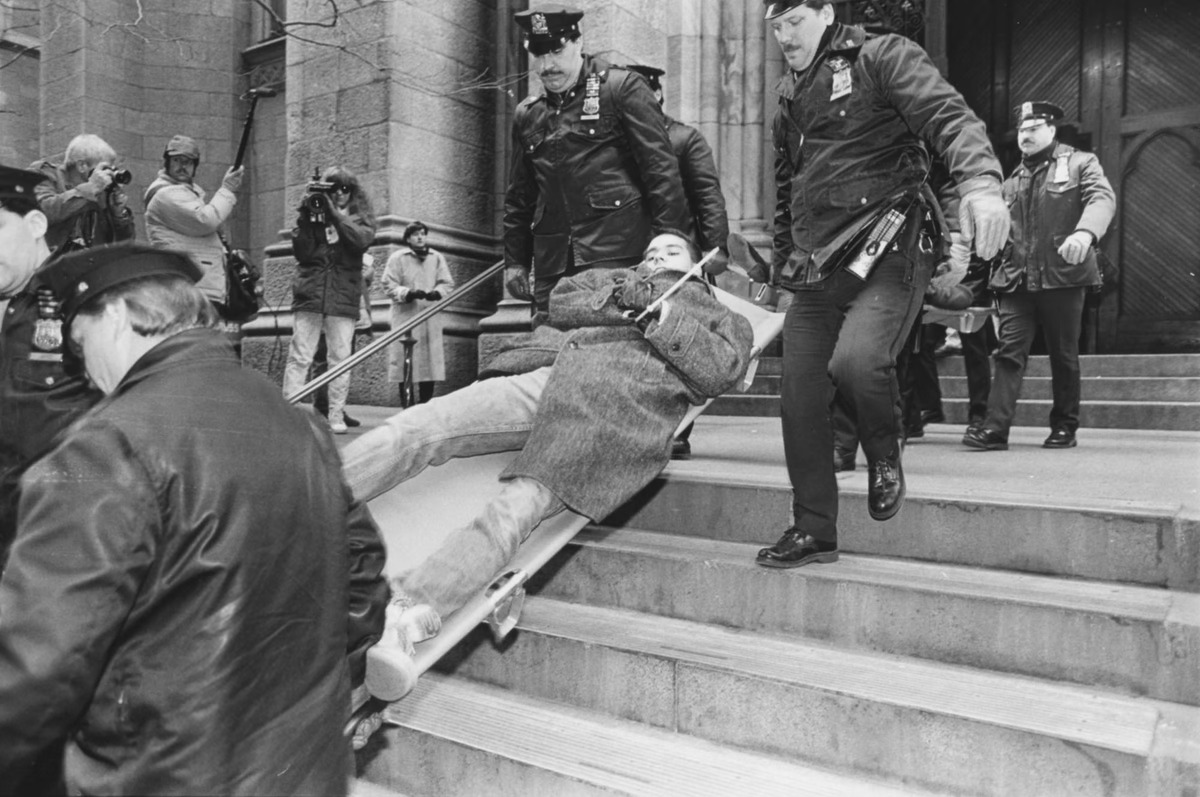
Manhattan, 1989: A protester is carried away during an ACT UP Stop the Church direct action at St. Patrick’s Cathedral. © Brian Palmer
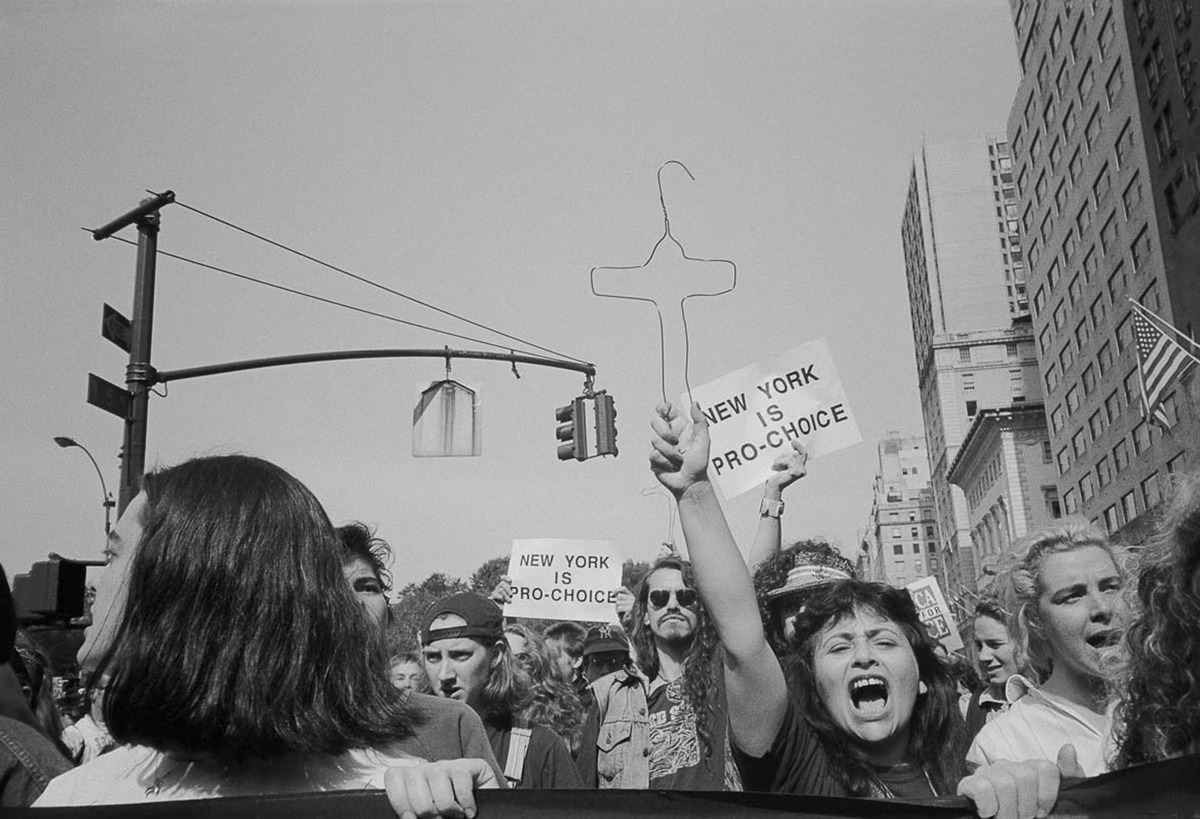
Manhattan, 1992: A woman holds up a clothes hanger in the shape of a crucifix at a pro-choice march. © Sandra-Lee Phipps
Women’s Rights
The 1989 Supreme Court Webster v. Reproductive Health Services decision restricting abortion rights reinvigorated the reproductive rights movement in New York City, as thousands rallied in support of abortion rights at Union Square Park. Webster upheld a Mississippi law banning abortion counseling, referral, or practice from any institution receiving public funding, unless it was to save a woman’s life. The direction action group Women’s Health Action and Mobilization (WHAM!) gagged the Statue of Liberty and joined forces with ACT UP in support of sexual freedom and the separation of sex and reproduction. Together, they attacked the Catholic hierarchy’s antiabortion activities, opposition to birth control and sex education in public schools, homophobic rhetoric on AIDS, and opposition to homosexuality in the 1989 and 1990 Stop the Church protests, which drew thousands of participants as well as sharp criticism.
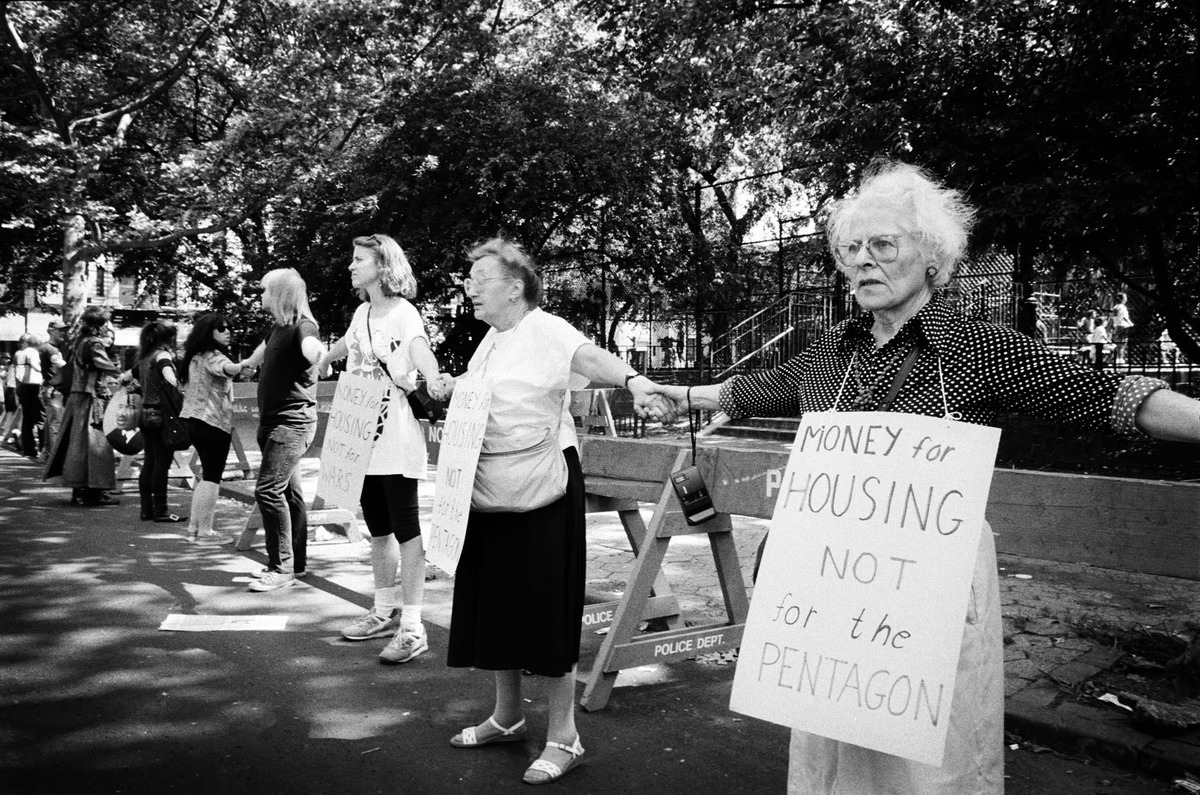
Manhattan, 1991: Lower East Side residents hold hands around Tompkins Square Park to protest the city’s forceful closure of the area. © Q. Sakamaki
Via: The spirit of New York protest is celebrated in “Whose Streets? Our Streets!” at the Bronx Documentary Center.
Would you like to support Flashbak?
Please consider making a donation to our site. We don't want to rely on ads to bring you the best of visual culture. You can also support us by signing up to our Mailing List. And you can also follow us on Facebook, Instagram and Twitter. For great art and culture delivered to your door, visit our shop.

